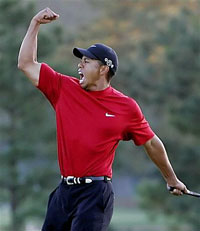 Profile
Profile
An intermediate golfer has worked hard to go beyond beginner status. They break 100 easily and may even break 90 on a regular basis.
An intermediate golfer understands that hitting down on the ball makes it go up with the irons, so you’re starting to make consistent contact with the ball. You are beginning to understand the details of swing plane and clubhead path, the keys to getting to be a really good golfer.
You hit about 3-6 greens in regulation per round so you see a few birdie chances but you don’t convert many because your putting is not sharp.
Your biggest problem is inconsistency. You may have a stretch of really good holes but those double bogeys and snowmen still creep into your round.
You don’t really know how to work the ball in both directions so you try to “dance with who you brung to the party” which is probably still a moderate to severe slice. Sometimes that dancing partner can look pretty ugly.
You sort of know how far you hit each club but your inconsistency makes you unsure of what club to use on many shots.
You feel like your golf game is close to being good sometimes but you’d like to know what to focus on to really get better and start shooting in the 80s consistently — and breaking 80 would be a dream come true.
A Golfer Is As A Golfer Does
| BEGINNER | INTERMEDIATE | ADVANCED | PRO | |
| Ave. Score | 100+ | 85-100 | 70-85 | below 70 |
| Warms up for an hour before playing | Never | Maybe | Usually | Always |
| Has consistent preshot routine | Never | Maybe | Usually | Always |
| Knows how far they hit each club | Never | Maybe | Usually | Always |
| Checks yardage to target for each shot | Never | Maybe | Usually | Always |
| Has equipment fit for their game | Never | Maybe | Usually | Always |
| Knows rules of golf | Never | Maybe | Usually | Always |
| Plays within their capabilities | Never | Maybe | Usually | Always |
| Has taken lessons | Never | Maybe | Usually | Always |
| Understands swing technique | Never | Maybe | Usually | Always |
| Ave. # of greens in regulation | 0-3 | 3-8 | 8-12 | 12-16 |
So in many ways becoming a better golfer is about doing the things that a better golfer does. So we’ll try and focus on the key golf learnings that an intermediate needs to master to be able to reach the next level.
Intermediate Fundamentals
As an intermediate golfer it’s time to take your game to the next level.
That means…
- Learning how far you hit each club
- Developing a consistent Preshot Routine
- Learning good Course Management
- Getting that short game “up to par”
For an intermediate you don’t need to spend quite as much time on the range. Now it’s time to learn how to really play golf On the Course. This is the only place you can really learn to play the game. When you get a little better it will be back to the range to really fine tune those final essentials for a great golf swing. But now lets learn how to play the game of golf.
And the game is ultimately a game of strategy. How do I get the ball in the hole in the fewest number of shots? That’s the whole point.
What an Intermediate Works On
How Far Do You Hit Each Club?
Today with all the yardage markers on the course and the excellent GPS systems for checking yardage there’s no excuse for not knowing how far you hit each club. Until you know you really can’t strategize and begin to play golf like the Chess game that it is.
If you don’t own one why not borrow one or rent one and take it to the range or use it on the course. If you have a course with the GPS built into the carts, spend some time on that course until you get a feel for just how far you hit each club. This is important stuff and worth the time and money. You may make your money back just with the golf balls you save.
When you’re presented with a hole that has a bunker that takes 180 yards to clear on the right and water that comes into play at 220 yards on the left, that’s no time to not know what club you can hit 200 yards. That’s just common sense. Good golfers call it Course Management. And course management is the key to getting rid of those double bogeys and snowment.
PreShot Routine
One of the big differences between an intermediate golfer and an advanced golfer is the Preshot Routine. Every excellent golfer has a very consistent routine before every shot. That’s one of the things that makes them consistent. They try to make every shot feel the same. That way when you face a tough shot that you have a little less confidence in succeeding at, you can calm your body and mind with the routine and tell it “it’s just another shot.”
So what is a preshot routine? It’s the series of movements before the swing that prepare the golfer to hit the shot. The waggle, and swing trigger are the final parts of the PSR.
It usually starts with the player standing behind the ball, visualizing the shot to be played and then approaching the ball, aligning the body and the clubhead, the waggle, and the swing trigger. All good golfers have practiced (and continute to practice) their PSR until it is automatic and almost unconcious.
Here’s a video that explains just how to create a consistent Preshot Routine…
Let’s break down each step.
Visualization
A big part of getting focused on the target is building a strong mental image of the shot to be played. Jack Nicklaus talks about “going to the movies” where he precisely builds a mental movie of the shot, complete with intended ball flight (draw or fade, high or low), the ball landing on the green and rolling to the hole.
It may sound silly but a vivid mental image of the EXACT shot that you want to play is what separates the good, from the bad, from the ugly shot. Even the best golfers will tell you that they only hit a handful of shots exactly as they envision in a round but a total commitment to trying to achieve a precise shot is what helps eliminate those ugly shots. The difference between a 90’s golfer and a 80’s golfer is not that they hit that many more great shots, they just hit fewer bad shots (and when they do hit a bad shot then don’t let it turn into two in a row). A good preshot routine will eliminate that bottom 20% of your shots.
Alignment
After the mental image has been created from behind it’s time to approach the ball. First make sure your grip is correct. Many players have a precise gripping procedure that is really part of their Pre Shot Routine (Bob Tway) to make sure they are gripping correctly. Make sure you have taken your grip before you approach the ball. At the ball, the clubhead is placed behind the ball square to the target.
How do you make sure the clubhead is aligned correctly?
Good players each do this differently but Jack Nicklaus and Tiger Woods do it the same way. As they stand behind the ball, they pick something a few feet in front of the ball and aligned with the target. It could be a blade of grass an old tee or whatever. When they approach the ball they align the clubhead to that intermediate target.
This just proves how critical clubhead alignment is to the best golfers — and how difficult it can be to achieve. Only after the club alignment is set correctly are the feet and body moved into place parallel to that target line.
Into the Swing
Meanwhile, the body is in constant motion creating rhythm and freeing the body of tension. The waggle frees the hands and arms and moving the body weight from front foot to back foot helps create the feeling of relaxed, tension free readiness.
While you waggle, your mind and eyes move back and forth from ball to target creating the focus required to ‘swing the clubhead through the ball to the target.’ The attention is not on any one thing but feels as if you are trying to collect all of the aspects of the shot together as one; the shape of the shot, the ball, the target, and clubhead alignment. When you finally look at the ball for the last time you still see the target in your mind. Your swing trigger begins the swing, and slowly and smoothly you move the clubhead back into the swing. It’s not rushed. The mind only sees the target. There are no doubts. You stay committed to the shot you visualized.
“Sure,” you say. “Easier said than done. The last thing I’m thinking about is the OB to the right.”
The point is, even though you may not achieve that great shot you envisioned every time, focusing on that perfect shot will free the mind and body to do it’s best. Your percentage of good shots will go up and the number of bad shots will go down. Wether you are a beginner or a pro, a good Pre Shot Routine will improve your game. When you’re on the range try practicing your PSR on every shot.
Course Management
Let’s look a little more closely at what course management is about. This is what you need to know to be a good course manager…
- How far you hit each club
- Where the trouble is on the holes you play
- How to swallow your pride and play within yourself
Of course the hardest one is number 3.
The secret to good course management is not only knowing where trouble is but knowing the percentages of sucess for all the possible shots. To get rid of those big numbers you have to choose shots that have a better than 75% success rate.
For example…
Suppose the hole you have to play is a long par 4 (say 400 yards) with water all along the right side. Here’s the facts…
- You’ve been slicing your driver all day so the chances of staying out of the water are slim (lower than 50% if you are honest).
- Besides you only hit your driver about 220 yards when you nail it so even a top 20% shot is going to leave a good 180 yards to the hole.
- By the way, the green is heavily bunkered with water to the right as well.
What is the correct shot to play in this situation?
Time to swallow your pride and hit a 5 iron or hybrid and turn the hole into a 3 shot, easy par 5. If you hit your 5 iron 150 yards you’ll have 250 left so another 5 iron will leave 100 yards to the green. The percentages for getting on in 3 and two-putting would be pretty good. So the percentages look like this.
- Driver in fairway 40-50% at best
- Hybrid in fairway 60-70%
- 5-iron in fairway 70-80%
And the beauty of choosing the high-percentage shot is it will lower your tension level and you’ll make a better swing. Your tension will be high when you have to pull off a low-percentage shot which just makes success that much more unlikely.
So be honest and know which shot will provide the least amount of tension and that is the shot you need to choose. If you do this those big numbers will be a thing of the past.
Short Game
If you watch the pros they almost always get up and down when they miss the green. Even though Tiger plays superb from tee to green, it’s his short game that always keeps him in a hole. You can just tell he hates bogeys. That’s how you should feel about them too if you want to be a good golfer.
Once you have a great short game the rest of your game will start to improve. You’ll swing freely and become much more focused in general because you’ll know you can save strokes around the green. Great players have great short games. It’s that simple.
Want some motivation? Start keeping track of how often you get up and down. You can’t improve what you don’t measure so once you know the percentage of times you get up and down from off the green you can begin to improve this statistic.
What About Other Statistics?
In fact a great way to start improving your game is to know what you need to work on. The top 3 stats you should know are…
- Greens in Regulation
- Total Putts Per Round
- Up-and-Down Percentage
If you’re really serious you’ll also keep track of your fairways hit as well. That way you’ll know your major weaknesses and what you should focus on in your practice.
Putting
Of course putting is one of the most important aspects of the game. Close to half of our shots are played with the flat stick so of course this part of your game requires considerable attention.
I know for me my putting is critical. I think saving par with a 5-10 foot putt is one of the best feelings you can have. And part of being a good putter is concentration and focus. Like Tiger Woods, it really helps if you really hate to make bogeys and double bogeys. Great putting can save a lot of strokes. I know if I couldn’t putt well I’d average 3-4 more shots per round.
As an intermediate you probably have found a putter that you feel comfortable with. If not make darn sure you go find one before you do anything else. There’s plenty to choose from so head to the golf store and spend some time trying them out. Also consider a putter fitting too.
Here’s master clubmaker Ralph Maltbie with a couple of videos as he introduces the 5 putter fitting variables.
Putting Technique
Putting is a very personal thing but there ARE some things that are common to all good putters. Most good putters keep their eyes directly over the ball. This way it is easy to just tilt your head to see the target line.
Most good putters also keep a VERY steady head throughout the stroke. Peaking (looking up) will move the shoulders and make the ball go offline (usually to the right). In fact, one good swing thought is ‘don’t move your head until you hear the ball go in the hole.’ Watch Annika Sorenstam putt and you’ll see her do this often.
Also having the ususal target oriented preparation is critical.
- View the putt from all sides and particularly from behind
- Have a clear target/shot visualization, a pre shot routine, and a good swing trigger.
- Give the hole a good hard look. Imprint that image in your mind.
And also, don’t forget The Essense; swing the clubhead through the ball to the target with light grip pressure.

